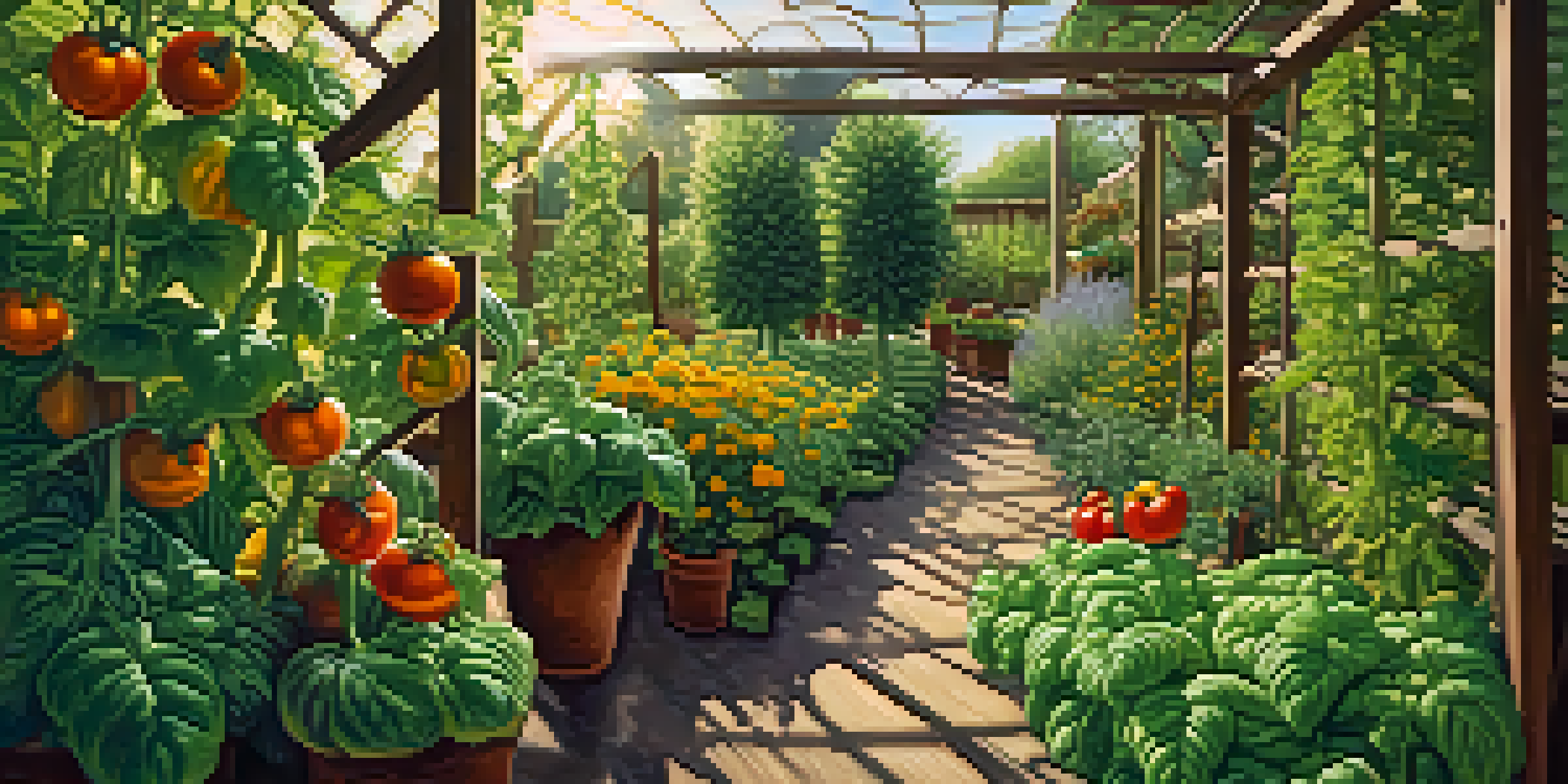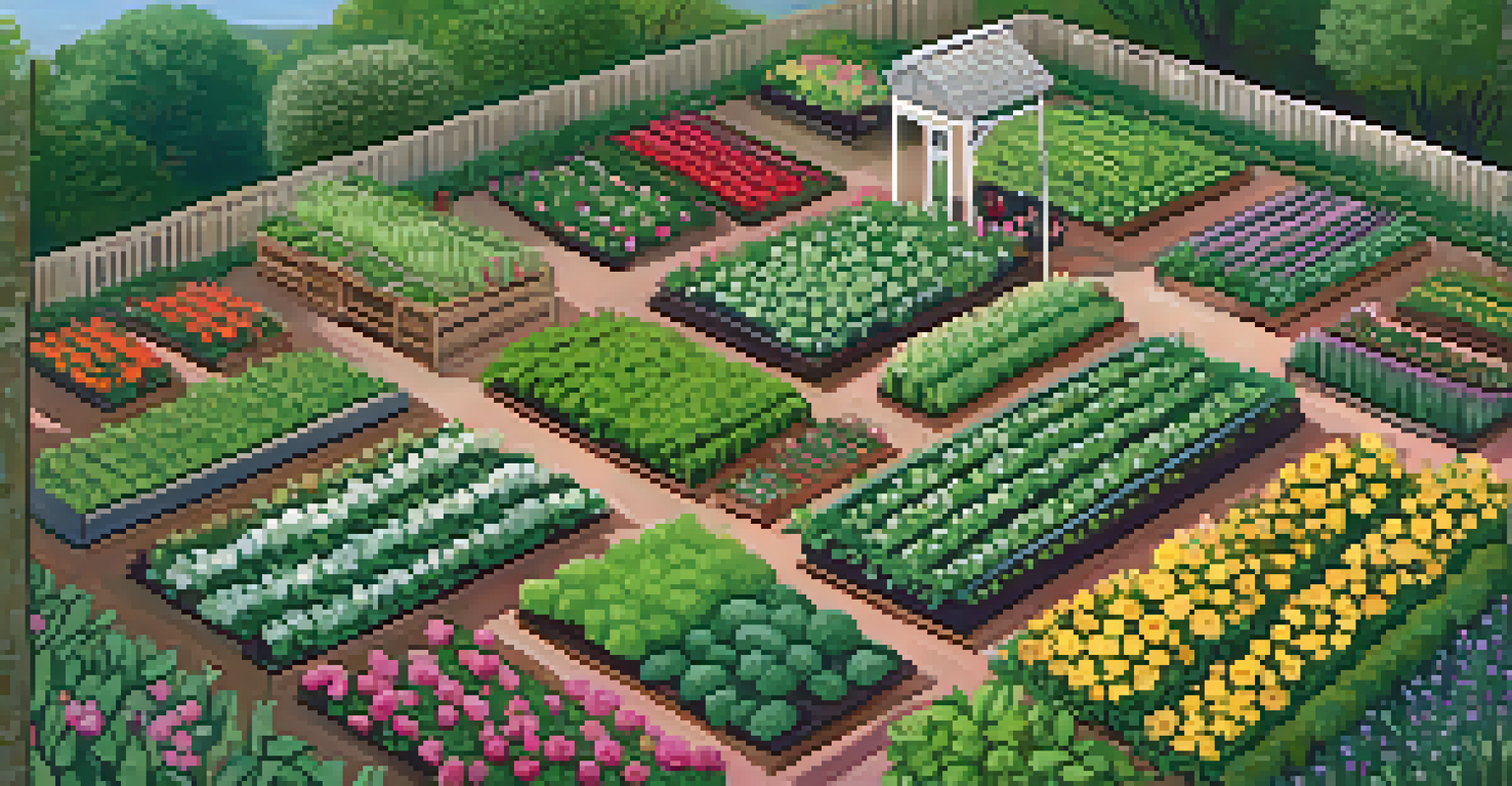Companion Planting: Boosting Growth with Strategic Choices

Understanding Companion Planting and Its Benefits
Companion planting is the practice of growing different plants together for mutual benefits. This age-old gardening technique can promote healthier plants, enhance growth, and even deter pests. For example, marigolds are often planted alongside vegetables to repel aphids and nematodes, showcasing how strategic choices can create a thriving garden ecosystem.
To plant a garden is to believe in tomorrow.
By understanding the relationships between various plants, gardeners can create a more productive and harmonious environment. Some plants may attract beneficial insects, while others might provide shade or support. This synergy not only boosts plant health but can also improve yield and flavor, making your garden a more rewarding experience.
In essence, companion planting is about making informed decisions based on nature's relationships. It allows gardeners to maximize their space and resources while minimizing the need for chemical interventions. As we dive deeper into this topic, you'll discover the key pairings that can transform your gardening approach.
The Science Behind Companion Planting
At its core, companion planting is grounded in the understanding of plant biology. Different plants can affect each other’s growth, nutrient uptake, and resistance to pests and diseases. For instance, legumes like beans can fix nitrogen in the soil, benefiting neighboring plants that require this nutrient to thrive.

Moreover, some plants release natural chemicals, known as allelochemicals, that can inhibit the growth of weeds or harmful pests. This natural defense mechanism can lead to a healthier garden with less competition and fewer pests. For example, basil planted near tomatoes can enhance their growth and flavor while repelling flies and mosquitoes.
Benefits of Companion Planting
Companion planting enhances plant health, promotes growth, and naturally deters pests, creating a thriving garden ecosystem.
By harnessing these natural interactions, gardeners can create a self-sustaining garden that requires less maintenance. Understanding the science behind these relationships can empower gardeners to make strategic planting decisions, ultimately leading to a flourishing garden.
Ideal Companion Plant Pairings
Choosing the right companions is crucial for successful gardening. Some classic pairings include tomatoes and basil, which not only thrive together but also enhance each other's flavor. Another effective combination is corn, beans, and squash, known as the 'Three Sisters,' which supports one another's growth while utilizing space efficiently.
The more you know about the plants in your garden, the more you can help them thrive.
Additionally, planting garlic near roses can deter aphids, while radishes can help break up compacted soil when planted alongside slower-growing vegetables. These pairings highlight how diverse plants can benefit each other, creating a balanced garden ecosystem.
Experimenting with different combinations can lead to exciting discoveries in your garden. Keep in mind that local climate and soil conditions can also influence these relationships, so don’t hesitate to try new pairings that suit your unique gardening environment.
Companion Planting for Pest Control
One of the primary benefits of companion planting is its ability to control pests naturally. By choosing plants that repel unwanted insects or attract beneficial ones, gardeners can significantly reduce the need for pesticides. For instance, planting nasturtiums can draw aphids away from more vulnerable plants, effectively acting as a decoy.
Similarly, certain herbs like dill and cilantro can attract ladybugs and lacewings, which are natural predators of aphids, caterpillars, and other pests. This natural pest control method promotes a healthier garden ecosystem and can lead to better yields without harmful chemicals.
Natural Pest Control Techniques
Using plants that repel pests or attract beneficial insects can significantly reduce the need for chemical pesticides in the garden.
By integrating pest-repelling plants into your garden design, you can create a more resilient space that thrives in harmony with nature. This approach not only protects your crops but also contributes to a more sustainable gardening practice.
Enhancing Soil Health with Companion Plants
Soil health is vital for a successful garden, and companion planting can play a significant role in improving it. Certain plants, like clover and other legumes, can fix nitrogen in the soil, enriching it for neighboring crops. This natural fertilization reduces the need for synthetic fertilizers, promoting a healthier growing environment.
Deep-rooted plants can also help break up compacted soil, allowing better water and nutrient absorption. For example, planting carrots alongside shallower-rooted crops can enhance soil structure and aeration, benefiting all plants involved.
In essence, choosing companions that contribute to soil health can lead to a thriving garden. A rich, well-balanced soil not only encourages stronger plants but also increases resilience against pests and diseases, creating a sustainable garden ecosystem.
Seasonal Companion Planting Strategies
Timing is everything in gardening, and seasonal companion planting can maximize growth and yield. By understanding the growing cycles of different plants, gardeners can implement strategies that ensure plants are at their peak when paired together. For instance, planting fast-growing radishes alongside slower-growing carrots can allow for a staggered harvest.
Additionally, rotating companion plants each season can prevent nutrient depletion and reduce pest buildup. This practice not only enhances soil health but also keeps the garden dynamic and productive throughout the year.
Improving Soil Health Naturally
Certain companion plants can enrich soil health through nitrogen fixation and improved soil structure, leading to stronger crops.
As you plan your garden, consider how seasonal changes affect plant interactions. Incorporating seasonal strategies can lead to a more productive and resilient garden, allowing you to enjoy fresh produce all year long.
Getting Started with Companion Planting
If you're eager to dive into companion planting, start by researching which plants thrive together. Many resources and companion planting charts are available to guide you in selecting the best pairings for your specific garden. Begin with a few simple combinations to see how they perform in your unique environment.
As you gain experience, don’t hesitate to experiment with new pairings and techniques. Keep a gardening journal to track successes and challenges, allowing you to refine your approach over time. Remember, gardening is a journey filled with learning opportunities.

Ultimately, companion planting can transform your gardening experience. By making thoughtful decisions about plant pairings, you can create a vibrant, productive garden that thrives in harmony with nature.